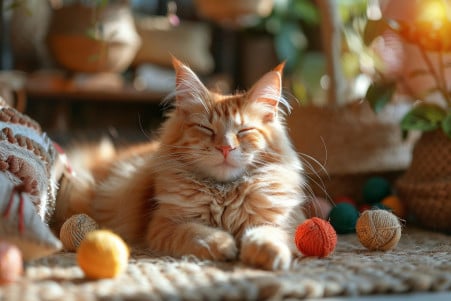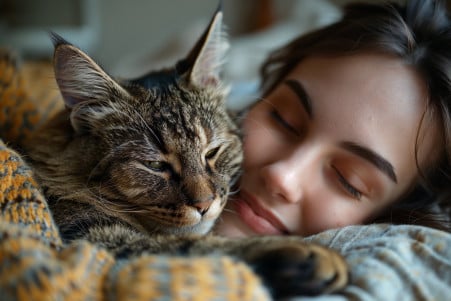How to Talk to Your Cat: Understanding Cat Communication
5 March 2024 • Updated 4 March 2024

From meows to tail flicks, you can learn to understand what your cat is trying to tell you. In order to ‘talk to your cat’, you need to be able to read their body language and understand their vocalizations.
For example, a tail that’s sticking straight up is a sign of a happy cat, while a hiss is a sign of a cat that’s feeling threatened or aggressive. Meows can also mean different things, from a simple hello to a request for food.
To make sure you’re getting your message across to your cat, make sure you’re using the right tone and body language, including soft vocalizations, slow blinks, and giving your cat the space they need.
Taking a deep dive into the world of cats, we’ll look at how animal behaviorists and veterinary scientists have studied cat-human communication through interdisciplinary research. You’ll find out that cats have a sophisticated way of communicating through vocalizations, body language, and scent. Through an exploration of common behaviors and the science of cat communication, this article offers practical tips for interpreting and responding to your cat’s individual communication style.
How can you understand and communicate with your cat?
Understanding Cat Sounds
Cats have a wide range of vocalizations, and each type of sound has a different meaning. According to the Humane Society of the United States, a meow can be used as a greeting, a command, or even an announcement, while purrs are usually a sign of happiness.
However, cats can also purr when they are stressed or sick as a way to comfort themselves. Meanwhile, growls, hisses, and spits are all signs of discomfort or aggression, and if your cat is making these sounds, it’s best to leave them alone.
Studies have shown that domestic cats have a much more extensive vocal repertoire than their wild relatives, with up to 21 different types of vocalizations having been identified. Perhaps most interestingly, cats tend to change the frequency of their vocalizations when they are communicating with humans, using a wider frequency range, which may be an attempt to take advantage of our greater sensitivity to the frequency range of human speech.
Cat owners can improve their ability to communicate with their pets by learning to recognize the differences in pitch, volume, and frequency in their cat’s vocalizations. For example, a high-pitched meow may be a sign of distress or a request for attention, while lower-pitched sounds may indicate frustration.
Learning to recognize and respond to these vocal cues with sensitivity and understanding can help strengthen the bond between cats and their owners, and it can also help us better understand the nonverbal but highly communicative language of cat body signals.
Decoding the Cat: How to Understand Cat Body Language
Cats rely heavily on body language to communicate, and it’s up to us to understand what they’re trying to say. A cat’s tail, ears, whiskers, and eyes all provide clues to how the cat is feeling.
For example, a cat often holds its tail up when it’s feeling confident, but as with all body language, context is important; Tuft + Paw points out that a high tail can also be a sign of aggression.
Meanwhile, Cats Protection explains that relaxed eyes and slow blinking are signs that a cat is happy, while dilated pupils can indicate that a cat is feeling stressed or anxious.
Some body postures are more obvious, like the ‘Halloween cat’ position with an arched back and bushy tail, which is a clear sign of fear or aggression. On the other hand, cats knead with their paws when they’re feeling happy and secure, a behavior that’s often associated with the way kittens knead their mother’s belly. Cats also show affection by head-butting, a behavior that’s a sign of trust and bonding.
To show cats that we understand and feel the same way, Purina recommends using body language to communicate with cats, like slow blinking to show trust or turning our heads to the side to show respect and non-threatening behavior.
However, it’s important to remember that all body language should be considered in context, as misreading your cat’s body language can lead to misunderstandings and stress. Learning to understand and communicate with your cat through body language can help you build a stronger bond with your pet.
The Science of How Cats Communicate With People
The way cats communicate with their human friends is a complex exchange of signals. A study in PLOS ONE demonstrates the complexity of cat-human communication by showing that cats can pick up on human vocal intonations and respond to them. Another study in Scientific Reports found that cats can learn to recognize their own names and understand human pointing, suggesting that they have social cognitive abilities similar to other domesticated animals.
A study in Animal Cognition demonstrates that cats can follow the direction of a human’s gaze to learn about their environment. This shows that cats can form a mental model of their human’s emotional state, which enables them to interact with their human’s emotions in a back-and-forth way. Cats can pick up on their owner’s emotions and adjust their behavior to comfort or solicit attention from them.
Like with humans, socialization in the first few months of life is important for the development of communication. Kittens that are exposed to people during a critical period are more likely to be social and adaptable.
This trust and comfort is the foundation of effective communication and a relationship that’s beneficial for both cats and their human friends. Knowing these facts about how cats communicate with people can help you and your cat have a more fulfilling relationship.
Building Trust with Responsive Interaction
At the heart of the cat-human relationship is the idea of interspecies communication, and yet it is human behavior that is most important in building a strong bond. As Dr. Dennis Turner’s article in the Encyclopedia explains, how humans respond to cats’ communication signals is key to building trust. Not only does regular and gentle interaction help to calm the cat, but it also sets up a pattern of communication that leads to trust.
It is important for humans to be responsive to cats’ communication signals, including their attempts to initiate interaction and their vocalizations, as Dr. Turner’s article points out.
For example, a cat is more likely to approach and interact with a person who is visibly responsive to them, which shows that a human’s state of attention can have a big impact on a cat’s behavior.
This is backed up by a study by Dr. Gérard Leboucher in Animals, which found that cats are more responsive to visual and bimodal signals from humans who are paying attention than to vocal signals alone.
By being responsive to cats’ signals and maintaining regular interaction patterns, humans can improve their communication with their cats. The rewards of doing so are great, and can lead to better emotional health for both the cat and the human.
Cat owners can build a relationship that improves the quality of life for both the cat and the human by recognizing the cat’s attempts to communicate and responding with attention and care. This will be further enhanced by recognizing and honoring the complex ways that cats use scent to mark their territory and communicate with others.
Decoding the Chemical Language of Cats
Scent is a rich form of communication for cats, and every head bunt and urine mark sends a different message. According to TexVetPets, cats have specialized sebaceous glands all over their bodies, including the head, tail, lips, chin, and paw pads. These glands produce pheromones that cats use to mark their territory, establish their place in the social hierarchy, and recognize members of their social group.
Male cats who are more dominant are more likely to mark their territory.
The Flehmen response, according to Kira Ramdas and her co-author, a Doctor of Veterinary Medicine, is a special behavior that helps cats process pheromones. When cats curl back their lips, they bare a special organ that processes the chemical signals in the pheromones, allowing them to better understand the message.
A study from the University of California, Davis, published in Scientific Reports, found that cats use odors from bacteria in their anal glands to communicate with one another. While these odors are undetectable to humans, they have a significant impact on feline social behavior and territorial, mating, and competitive behaviors.
It’s important for cat owners to learn about and respect these chemical forms of communication. By understanding that cats need to scent mark and not cleaning marked areas too thoroughly, you can help ensure that your cat feels safe and secure in its territory. Recognizing the importance of olfactory communication can help us better understand cats’ natural behaviors and create a more peaceful living situation in our shared environment.
Why It’s Important to Speak Cat
Throughout our exploration of how to speak cat, we’ve delved into the many ways cats communicate, from the different types of meows and purrs to body language and scent marking. By understanding these forms of communication, we can better understand what cats want, how they feel, and what they’re trying to say.
We’ve also seen how paying attention to a cat’s sounds and movements and then responding accordingly can help us build a stronger relationship with our pets. And we’ve learned how we can help cats feel more secure and comfortable by respecting their territory and pheromone needs.
All of these things help us build a better relationship with our cats and improve our quality of life. But the advantages of speaking cat go beyond companionship. They also help us build a deeper understanding that benefits both cats and the people who care for them. When we listen to and understand the many ways cats communicate, we can build a relationship based on trust, love, and a lifetime of friendship.


